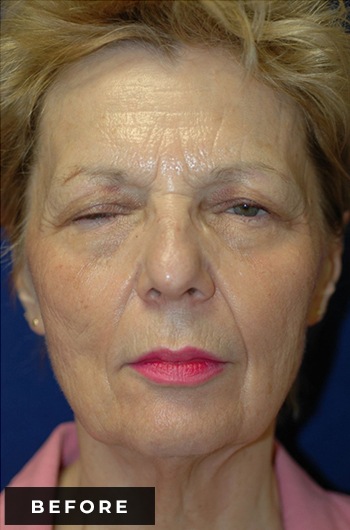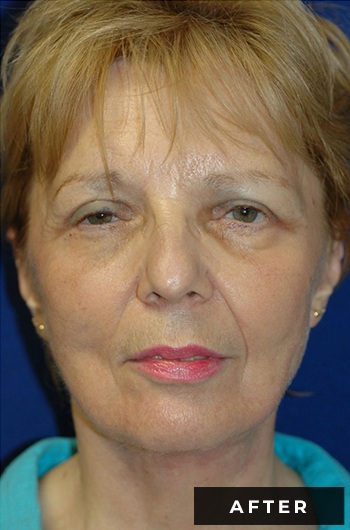3800 Reservoir Rd, 1st Floor Gorman
Washington, DC 20007
6862 Elm St, Suite 800B
McLean, VA 22101
Rhytidectomy (rit-id-ECK-toe-mee) also known as facelift surgery is done to lift and tighten the soft tissues in the face and to remove the excess skin folds created by aging.
Clinical evaluation begins with the assessment of your specific facial anatomy and your desires for improvement. Dr Reilly will then work with you to create a plan that aligns your goals with potential surgical treatments based on your anatomy.
Generally, this type of surgery is done to lift the sagging neck, jowls, and cheeks to promote a more youthful and well-rested look.
The technique for facelift involves incisions hidden in the natural creases in front of and behind the ears. The skin is lifted off the underlying soft tissues, which are then suspending back to a more youthful position. Excess skin is removed and the incisions are then closed very precisely with small sutures.
Most patients take one week off work, followed by another week of reduced activity. There will be bruising and swelling for 7-10 days. Sutures are typically removed 5-7 days after surgery. After 2 weeks, you may resume full activity.
A facelift is a surgical procedure performed by a head and neck surgeon to lift and tighten the soft tissues in the face and to remove excess skin folds and wrinkles caused by aging. This type of facial skin tightening procedure is done to lift the sag in your neck, jowls, or cheeks, and promotes a more youthful and well-rested appearance. Dr. Reilly is known for producing natural-looking cosmetic surgery results and performs both full-facelifts and mini-facelifts or “lower facelift.”
Dr. Reilly will create your natural facelift by making an incision in front of and behind your ears. The skin of your face will be lifted so the underlying soft tissue can be suspended back into a more youthful position. Dr. Reilly will remove an excess skin to make your face skin smoother. The incision lines are closed very precisely with small sutures and are well-hidden in the natural folds of your facial anatomy. A facelift surgery can be performed in conjunction with other surgeries, including jaw implants, cheekbone implants, face fat removal, or upper or lower blepharoplasty. Dr. Reilly also frequently performs microneedling, or “the vampire facial,” which is a skin resurfacing procedure, during facial cosmetic surgeries.
We recommend taking a full week off of work or school to adequately rest and recuperate from your facial rejuvenation procedure. We will see you in the clinic one week after your surgery to ensure everything is healing properly and to remove any sutures. Dr. Reilly may recommend you wear a soft fabric band around your head to reinforce the new shape of your facial contouring. Depending on your occupation, you may be feeling up to returning to work after that first week. You should expect to be taking it easy for the first two weeks after surgery; we recommend no heavy lifting or strenuous exercise for a full two weeks. Avoid any rigorous exercise or contact sports for six full weeks after this facial surgery.
Typically, procedures that are cosmetic in nature are considered “elective” by insurance companies. After your consultation with Dr. Reilly, you will be provided a personalized quote based on the scope of work discussed in your visit. We have a team who will help navigate you through the scheduling process.




Background
Over time, the face inevitably undergoes changes; the skin may loosen and become wrinkled. Creases may form between and around the eyes and mouth, and jowls may begin to form where the jaw line was once taught. Exposure to the sun, lifestyle, genetics, and gravity all contribute to the aging face. To achieve a more youthful appearance, Dr. Reilly may recommend a facelift.
Evaluation
Dr. Reilly will perform an in-depth analysis of your face from frontal and profile views. He will discuss how changes to different areas of your face may affect the appearance from each of these perspectives.
In the vast majority of patients, the desired aesthetic result is readily achieved. However, the possible complications of facelift surgery include but are not limited to the following:
Infection, bleeding, swelling, scarring, numbness, skin discoloration, asymmetry, fluid collection, delayed wound healing, displeasure with the cosmetic outcome, and allergic or other negative reactions to one or more of the medications or substances used in the operation.
Facelift is done by making a small incision near the hairline of the temple, in front of the ear. The incision will continue under the earlobe, behind the ear, blending into the hairline. When treating men, Dr. Reilly will align the incision line with their natural facial hair lines. The placement of the incision will vary on a case-by-case basis to minimize the appearance of scarring. Based on the pre-operative goals that have been discussed with Dr. Reilly, he may remove some of the fatty tissue in your face, as well as excess skin. The skin will be gently elevated off the underlying soft tissue, which is then repositioned into a more youthful location. Excess skin is then trimmed and Dr. Reilly will close the incision line with fine sutures and/or metal surgical clips. Dr. Reilly’s surgical precision eliminates the need to shave the hair around the face. Typically, the procedure time is dependent upon the extent of the surgery; the process averages three to four hours. Since the procedure is completed under general anesthesia, you will be asleep for the entirety of the procedure. It is necessary have reliable transportation home, and to have a family member or friend with you for the immediate recovery process. For your comfort, Dr. Reilly’s office can also coordinate an overnight stay in the hospital after your procedure. A dressing will be applied to cover the incision site. You should anticipate having swelling and bruising after the procedure, which will diminish within the first week or two.
Arrange for someone to stay with you for the first 24 hours.
Go to bed and rest, lying on your back, with your head elevated with 2-3 pillows. You should be lying at a 45 degree angle.
You may be up and around and able to go to the bathroom. You will be able to eat a light meal with assistance.
Take medication only as directed.
Some swelling, bruising and tightness of the bandages are a normal occurrence.
Place ice packs on the sides of the face and under the chin continuously for the first 48 hours (on for 20 minutes, then off for 20 minutes).
Avoid turning the head from side to side as this can cause tension on suture line and bleeding under the skin. Turn head and shoulders together for the first 10 days.
Keep the incisions moist with petroleum-based ointment. Cover any draining area with bandages. If they loosen, secure them with more tape. You can expect to have 1-2 drains in place overnight which will be removed the next day at your first post-operative visit.
You may be up and around as tolerated but expect to tire more quickly than usual.
Keep activity and meals light, avoiding meals that require significant chewing.
On the 3rd day, you can remove all bandages and gently shampoo your hair in the shower with baby shampoo. It is advised to let your hair air-dry, but you may use a cool setting if you need to use a hair dryer.
You will come into the office for a post-operative check-up and suture removal.
No alcohol for the first 7 days after surgery, which can increase bruising and swelling.
Your swelling and bruising will gradually fade over this time period, but it may persist for up to 3 weeks. You will come in for another post-operative check-up on 4-6 weeks after surgery. You may apply makeup to conceal bruising, but be sure to avoid anywhere near the incision lines for at least 10 days after surgery.
1. Rest and good nutrition are important healing factors, especially during the first 6 weeks.
2. Numbness, tingling, hardness, tightness, and bumpiness of the surgical area are common occurrences. If any of these things do occur, they will gradually subside over several months.
Message Sent!

Dr. Michael Reilly is double board-certified by the American Board of Otolaryngology--Head & Neck Surgery and The American Board of Facial Plastic & Reconstructive Surgery. He specializes in facial plastic surgery and Rhinoplasty.
Follow up appointments:
Medical emergency:
Clinical questions: